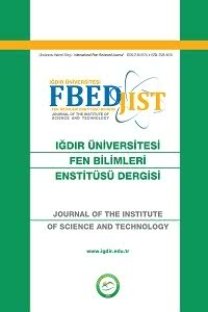Nano-CuO İle Hazırlanan Kompozit Kil Karışımlarının Kıvam Limitleri, pH ve Elektrik İletkenlik Özelliklerinin İncelenmesi
Nano malzemelerin kullanım alanları her geçen gün artmaktadır. Günümüzde birçok alanda olduğu gibi inşaat mühendisliğinde de nano partiküllerin kullanılabilirliği araştırmacıların dikkatini çekmektedir. Çalışma kapsamında, % 0.5, %1, %2 ve %3 oranlarında nano-CuO, yüksek plastisiteli kil ile interkalasyon yöntemi kullanılarak karıştırılmış ve elde edilen kompozit kil örneklerinin kıvam limitleri, pH ve elektrik iletkenlik özelliklerinin nano-CuO oranı ile değişimi incelenmiştir. Nanopartikülün eklenmesi likit limit değerlerini arttırırken, plastik limit değerlerinde göreceli olarak bir düşüşe neden olmuştur. Diğer taraftan, nano-CuO katkı oranı arttıkça pH ve elektrik iletkenlik değerlerinin arttığı tespit edilmiştir.
Anahtar Kelimeler:
Nanopartikül, bakır oksit, kil, kıvam limitleri, elektrik iletkenlik, pH
Investigation of Liquid Limit, pH and Electrical Conductivity Properties of Composite Clay Mixtures Prepared With Nano-CuO
The usage areas of nano materials are increasing day by day. As in many other fields, the availability of nano-particles in civil engineering attracts the attention of researchers. In this study, 0.5%, 1%, 2% and 3% nano-CuO was mixed with high plasticity clay by using intercalation method and the changes of consistency limits, pH and electrical conductivity properties with nano-CuO ratio of the composite clay samples were investigated. The addition of the nanoparticle increases the liquid limit values, also resulting in a relative decrease in the plastic limit values. On the other hand, as the ratio of nano-CuO additives increases, pH and electrical conductivity values increase.
Keywords:
Nanoparticle, copper oxide, clay, consistency limits, electrical conductivity, pH,
___
- Abu-Hassanein HS, Benson CH and Blotz LR, 1996, The Electrical Resistivity of Compacted Clays. Journal of Geotechnical Engineering, 122(5): 397–406.
- Akbulut RK, 2008. Yüzey aktif madde ile muamele edilen kilin bazı fiziksel ve kimyasal özellikleri. Yüksek Lisans Tezi, Atatürk Üniversitesi Fen Bilimleri Enstitüsü.
- Arabani M, Haghi AK, Mohamadzadeh Sani A, Kambozia N, 2012. Use of nanoclay for improvement the microstructure and mechanical properties of soil stabilized by cement. Proceeding of the 4th International Conference on Nanostructures (ICNS4), 12–14 March 2012, Kish Island, Iran.
- ASTM D 698-00a, 2003. Standard Test Method for Laboratory compaction Characteristics of Soil Using Standard Effort. AnnualBook of ASTM Standards, American Society For Testing and Materials, 04.08,West Conshohocken, pp. 78–87.
- ASTM D 4318, 2003. Standart Test Methods for Liquid Limite, Plastic Limit, and Plasticity Index of Soils. Annual Book of ASTM Standards, American Society For Testing and Materials, 04.08, West Conshohocken, pp. 582-595.
- Baykara T, 2008. Malzeme Enstitüsü Nano-malzeme Araştırmaları. Nano Teknolojide Ürüne Dönüştürülebilir Araştırma ve Ticarileştirme Konferansı ve Proje Pazarı, 22-23 Aralık 2008, İstanbul.
- Bryson LS and Bathe A, 2009, Determination of Selected Geotechnical Properties of Soil Using Electrical Conductivity Testing. Geotechnical Testing Journal, Vol. 32, No. 3
- BS 1377-2, 1990. Methods of test for soils for civil engineering purposes. Classification tests. British Standard, 31 August 1990.
- Ghasabkolaei N, 2013. The Effect of Using Nanoparticles on Geotechnical Properties of Cement-Stabilized Clay. Babol Noshirvani University of Technology Graduate School of Natural and Applied Sciences, Master Thesis (Printed).
- Kalinski RJ and Kelly WE, 1993. Estimating Water Content of Soils from Electrical Resistivity. Geotechnical Testing Journal, 16(3): 323–329.
- Kananizadehn N, Ebadi T, Rizi SEM, Khoshniat SA, 2011. Behavior of nanoclay as an additive in order to reduce Kahrizak landfill clay permeability. 2nd International Conference on Environmental Science and Technology, 26–28 February 2011, Singapore.
- Lee SY, Cho JW, Hahn PS, Lee M, Lee BY, Kim JK, 2005. Microstructural changes of reference montmorillonites by cationic surfactants. Applied Clay Science, 30: 174-180.
- Lou HL, Hsiao DH, Lin CK, 2012. Cohesive soil stabilized using sewage sludge ash/cement and nano aluminum oxide. International Journal of Transportation Science and Technology, 1 (1): 83–100.
- Moavenian MH and Yasrobi SS, 2008. Volume change behavior of compacted clay due to organic liquids as permeant. Applied Clay Science, 39(1): 60-71, DOI: 10.1016/j.clay.2007.04.009.
- Taha MR, Taha OME, 2012. Influence of nanomaterial on the expansive and shrinkage soil behavior. Journal of Nanoparticle Research, 14: 1190.
- Ünver E, 2015. Problemli Kil Zeminlerin Uçucu Kül İle İyileştirilmesi. Yüksek lisans tezi, Eskişehir Osmangazi Üniversitesi Fen Bilimleri Enstitüsü.
- Yoon KH, Choi WJ, Kang DH, 2000. PHotoelectrochemical properties of copper oxide thin films coated on an n-Si substrate. Thin Solid Films, 37: 250-256 Zaimoglu AS, Tan O and Akbulut RK, 2016. Optimization of Consistency Limits and Plasticity Index of Fine-grained Soils Modified with Polypropylene Fibers and Additive Materials. KSCE Journal of Civil Engineering, 20: 662. https://doi.org/10.1007/s12205-015-0540-8
- ISSN: 2146-0574
- Yayın Aralığı: Yılda 4 Sayı
- Başlangıç: 2011
- Yayıncı: -
Sayıdaki Diğer Makaleler
Meyve Suyu İşleme Tesisi Atıklarından Biyokompozit Ambalaj Malzemelerinin Üretimi
Seda ERSUS, Arzu YALÇIN MELİKOĞLU, Serap CESUR
ZnFe/Poly(N-metilpirol-co-o-anisidin) Kaplı Karbon Çelik Elektrodun Antikorozif Davranışı
Ordu İli (Türkiye) Ascidiacea (Tunicata, Chordata) Faunası Üzerine Bir Araştırma
Membrane Filtration of Methyl Orange
Serhat ŞAP, Hanbey HAZAR, Emine ŞAP
Mehmet Can ÖZDEMİR, Ömer SEVGİLİ, İkram ORAK, Abdülmecit TÜRÜT
Adem ERGÜN, Mert Olgun KARATAŞ
Gübre Kullanım Alışkanlıklarının Su Kalitesine Etkisinin Araştırılması: Konya İli Örneği
